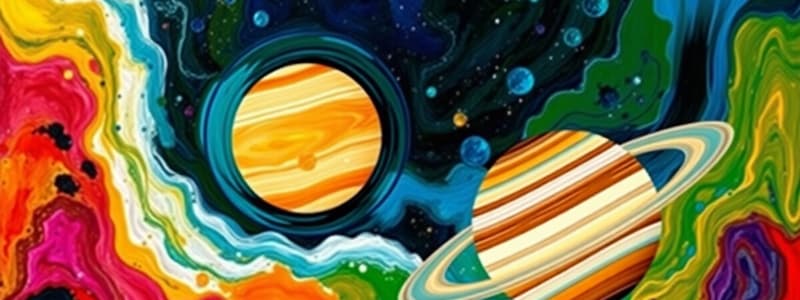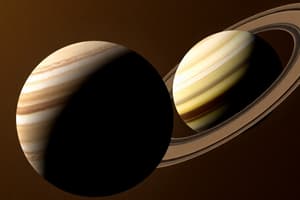Podcast
Questions and Answers
Which of the following characteristics is unique to Uranus among the gas and ice giants in our solar system?
Which of the following characteristics is unique to Uranus among the gas and ice giants in our solar system?
- Its primary atmospheric composition of hydrogen, helium, and methane.
- Its axial tilt, causing it to rotate on its side. (correct)
- Its classification as an ice giant, indicating a composition of heavier elements.
- The presence of a ring system, albeit faint.
A scientist discovers a new moon orbiting a gas giant. Which of the following findings would be most surprising, potentially challenging current understanding of moon formation and planetary systems?
A scientist discovers a new moon orbiting a gas giant. Which of the following findings would be most surprising, potentially challenging current understanding of moon formation and planetary systems?
- The moon possesses a dense atmosphere with evidence of volcanic activity. (correct)
- The moon exhibits synchronous rotation, with one side always facing the planet.
- The moon has a heavily cratered surface, indicating an old age.
- The moon's orbit is highly eccentric and inclined relative to the planet's equator.
If a space probe were to descend into the atmosphere of Neptune, which of the following changes would it most likely experience as it descends?
If a space probe were to descend into the atmosphere of Neptune, which of the following changes would it most likely experience as it descends?
- A steady decrease in wind speeds due to the planet's smooth surface.
- An increase in temperature and pressure, along with increasingly strong winds. (correct)
- A decrease in atmospheric density, making it easier to maintain altitude.
- A constant temperature and pressure, similar to conditions on Earth.
Which of the following best describes the composition and characteristics of Saturn's rings?
Which of the following best describes the composition and characteristics of Saturn's rings?
Europa, one of Jupiter's Galilean moons, is hypothesized to have a subsurface ocean. What evidence best supports this hypothesis?
Europa, one of Jupiter's Galilean moons, is hypothesized to have a subsurface ocean. What evidence best supports this hypothesis?
Flashcards
Gas Giants
Gas Giants
Large planets made mostly of gases like hydrogen and helium.
Jupiter
Jupiter
Fifth planet from the Sun; known for its Great Red Spot and many moons.
Saturn
Saturn
Sixth planet from the Sun, famous for its extensive rings.
Uranus
Uranus
Signup and view all the flashcards
Neptune
Neptune
Signup and view all the flashcards
Study Notes
- Gas giants are large planets primarily composed of gases, such as hydrogen and helium
- They are distinct from rocky planets like Earth, Mars and Venus
Jupiter
- Fifth planet from the Sun, and the largest in the Solar System
- Primarily composed of hydrogen and helium
- Has a faint ring system and a strong magnetic field
- Characterized by its Great Red Spot, a persistent anticyclonic storm
- Has numerous moons, including the Galilean moons: Io, Europa, Ganymede, and Callisto
- Ganymede is the largest moon in the Solar System and has its own magnetic field
- Europa is thought to have a subsurface ocean, potentially harboring life
Saturn
- Sixth planet from the Sun, known for its prominent ring system
- Primarily composed of hydrogen and helium
- The rings are made up of ice particles, dust, and rocky debris
- Has a complex atmosphere with visible bands and storms
- Possesses a large number of moons, including Titan, which has a dense atmosphere and liquid methane lakes
Uranus
- Seventh planet from the Sun, an ice giant
- Atmosphere is composed of hydrogen, helium, and methane
- Has a faint ring system
- Rotates on its side, with its axis of rotation tilted at about 98 degrees relative to its orbit
- Has several moons, including Miranda, Ariel, Umbriel, Titania, and Oberon
Neptune
- Eighth and farthest known planet from the Sun, also an ice giant
- Atmosphere composed of hydrogen, helium, and methane
- Has a dynamic atmosphere with strong winds and storms
- Possesses a faint ring system
- Has several moons, including Triton, which orbits in a retrograde direction
Studying That Suits You
Use AI to generate personalized quizzes and flashcards to suit your learning preferences.



